Overall I’ve had a great year though I’ve not hit most of my recording targets. I’ve had some of my best wildlife experiences ever which were even better for not always being expected. I started the year having recorded 4600 species in the UK and ended on 5241 an increase of 641. Having set myself targets at the start of the year I missed most of them both in terms of overall species recorded and taxonomic range. Some were understandable such as failing to achieve my Western Palearctic bird target due to not leaving the country. The reason for others was less clear. Having bought a nice aquatic net at the start of the year I went rock-pooling once and then didn’t look at anything aquatic or littoral again all year. I’ll keep them in my targets and try again next year but perhaps I don’t need to pursue the full spectrum of PSL and can just leave some groups for those with a more natural affinity with wet things.
Below is a breakdown of some of my highlights of 2021. The summary table is at the end of the post.
Lichens
I finally recorded a lichen, eleven lichens in fact. Most were very common species recorded in the winter around Benson apart from Teloschistes flavicans which was nice to see in abundance on Scilly and Solorina crocea which I added in Scotland.
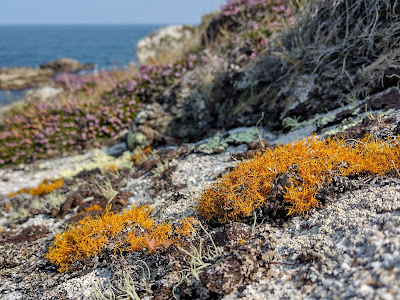 |
| Teloschistes flavicans |
 |
| Solorina crocea |
Fungi
I didn’t record many fungi in 2021 but I did see a few nice species. Smuts included Antherospora tractemae on Scilla verna in Cornwall, Exobasidium vaccinii on Vaccinium vitis-idea and E. myrtilli on V. myrtillus in Abernethy Forest and Microbotryum silenes-acaulis on Silene acaulis on Ben Lawers. I also recorded the Arctostaphylos associated bolete Leccinum vulpinum twice in the Cairngorms.
 |
| Antherospora tractemae on Scilla verna (TL), Microbotryum silenes-acaulis on Silene acaulis (TR), Exobasidium vaccinii on Vaccinium vitis-idea (BL) and E. myrtilli on V. myrtillus (BR) |
 |
| Leccinum vulpinum |
Vascular plants
2021 was a big year for plants. The obvious highlight was the result of a speculative trip to Combe Hill that almost didn’t happen. Jacques Turner-Moss and I had some spare time after enjoying skippers and gentians at Aston Rowant so decided to try for Gentianopsis ciliata (Fringed Gentian). On arriving we met some other naturalists who pointed us in the right direction and there it was a single, rather slug eaten, gentian ‘protected’ by a couple of small sticks. We were very pleased to see it but didn’t fully realise the significance until later when I tweeted the pictures and realised that ours was the first reported sighting of the species in the UK in around ten years. Obviously the other naturalists who pointed us in the right direction and whoever left the sticks had seen it before us but it was very satisfying to report the sighting and good to hear that a few more were found by other visitors in the following weeks and that seed was being collected for Kew. Hopefully this will be the start of a better future for the species in the UK.
Good to see Gentianopsis ciliata (Fringed Gentian) still hanging on today near Wendover. Recently thought extinct for a number of years at this, its only UK site #wildflowerhour pic.twitter.com/X9ogMG90JQ
— Sam Thomas (@sjthomasbotany) September 12, 2021
Stopped off at Orton on the way up to see Crepis praemorsa at its only UK site, quite a few still in flower which was nice pic.twitter.com/2lswHA9fXe
— Sam Thomas (@sjthomasbotany) June 21, 2021
Our first day in Scotland was spent in Glen Tilt visiting Melampyrum sylvaticum (Small Cow-wheat) and failing to access any of the vertiginous sites I’d noted for Polygonatum verticillatum (Whorled Solomon's-seal).
 |
| Melampyrum sylvaticum |
The following day on Ben Vrackie added the classic Astragalus danicus (Purple Milk-vetch) and Oxytropis halleri (Purple Oxytropis) as well as Cerastium alpinum (Alpine Mouse-ear), Hieracium clovense (Clova Hawkweed) and Luzula luzuloides (White Wood-rush).
 |
| Astragalus danicus and Oxytropis halleri |
Once we’d descended I couldn’t resist another attempt at Polygonatum verticillatum which involved a quick detour to Kinnaird Burn just outside Pitlochry where I spent an hour or two scrambling around and getting very wet and muddy without any luck before stumbling on a lovely patch of P. verticillatum after I’d given up and was making my way out of the woods.
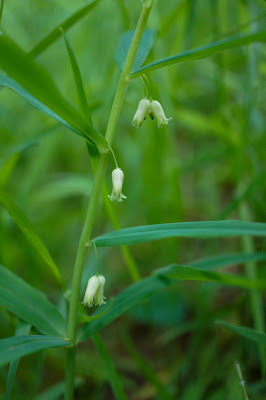 |
| Polygonatum verticillatum |
The third day was spent at Glen Fender Meadows revelling in the wonderful sedge flushes and adding Schoenus ferrugineus (Brown Bog-rush), Pseudorchis albida (Small-white Orchid) and Trichophorum cespitosum (Deergrass).
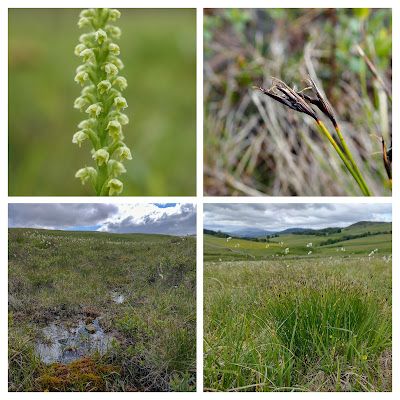 |
| Pseudorchis albida and Schoenus ferrugineus |
Moving on from the Pitlochry area we stopped in Aberfeldy to visit Weem Meadow adding abundant Meum athamanticum (Spignel) and a single plant of the target Crepis mollis (Northern Hawk's-beard) my final permanently established UK Crepis species.
 |
| Crepis mollis |
The final stop on the first Scotland trip was the botanical mecca of Ben Lawers. While we were slightly too early in the season for some of the specialties it still lived up to its reputation and I added sixteen species in one day. Highlights included Athyrium distentifolium (Alpine Lady-fern), Salix lapponum (Downy Willow), Draba norvegica (Rock Whitlowgrass), Cochlearia micacea (Mountain Scurvygrass), Sedum villosum (Hairy Stonecrop), Saxifraga cernua (Drooping Saxifrage), Myosotis alpestris (Alpine Forget-me-not) and, of course, Taraxacum cymbifolium (Ben Lawes Dandelion).
 |
| Saxifraga cernua and Taraxacum cymbifolium |
Returning to Scotland a couple of weeks later we based ourselves in a cottage in the heart of Abernethy Forest with easy access to wintergreens and Cairngorms. In the forest around the cottage I added Orthilia secunda (Serrated Wintergreen), Goodyera repens (Creeping Lady's-tresses), Corallorhiza trifida (Coralroot Orchid) and Linnaea borealis (Twinflower).
 |
| Linnaea borealis |
A walk up Cairn Gorm added Kalmia procumbens (Trailing Azalea), Arctostaphylos uva-ursi (Bearberry), Vaccinium uliginosum (Bog Bilberry), and Epilobium anagallidifolium (Alpine Willowherb). Descending through Coire an t-Sneachda added Cerastium nigrescens (Arctic Mouse-ear), Cornus suecica (Dwarf Cornel) and Taraxacum ceratolobum (Bright Green Dandelion). The following day I pottered around Insh Marshes enjoying the swamps and aspen woodland and added Carex chordorrhiza (String Sedge), Calamagrostis purpurea (Scandinavian Small-reed) and Calamagrostis stricta (Narrow Small-reed) all without sinking into the soupy depths. Next was a long walk in search of clubmosses. Starting out from Cairn Gorm parking I cut across into Strath Nethy where I had the whole glen to myself save a couple of Golden Eagles. After adding my first new clubmoss of the day Lycopodium annotinum (Interrupted Clubmoss) beside the path it was a steep scramble to the well known site for Diphasiastrum x issleri (Issler's Clubmoss) which was abundant across a small area of partly vegetated scree. After lunch I made it to The Saddle at the top of Strath Nethy and cut back and up toward Ciste Mhearad for a brief diversion from clubmosses in the form of Luzula arcuata (Curved Wood-rush). Heading over the top and into Corie na Ciste it took a bit of searching but I eventually found Lycopodium lagopus (Hare's-foot Clubmoss), my ninth and final extant UK clubmoss species.
 |
| Lycopodium annotinum, Diphasiastrum x issleri and Lycopodium lagopus |
Before heading back south I stopped in Glenmore Forest for Moneses uniflora (One-flowered Wintergreen) which was a satisfying end to the trip after having failed in my first two attempts to find the species in Abernethy Forest.
 |
| Moneses uniflora |
A weekend on the Lizard in the spring added Isoetes histrix (Land Quillwort) and Juncus capitatus (Dwarf Rush). The former was already very dead but still a satisfying oddity that I’d wanted to see for many years.
 |
| Juncus capitatus |
Whilst plants weren’t my main target on Scilly I ended up adding 27 of the island’s cornucopia of non-natives. These included a range of Aizoaceae such as Aptenia cordifolia (Heart-leaf Iceplant), Lampranthus falciformis (Sickle-leaved Dewplant), Oscularia deltoides (Deltoid-leaved Dewplant) and Drosanthemum floribundum (Pale Dewplant); shrubs such as Pittosporum crassifolium (Karo), Coprosma repens (Tree Bedstraw) and Brachyglottis repanda (Hedge Ragwort) and other species including Malva pseudolavatera (Smaller Tree-mallow), Senecio minimus (Toothed Fireweed), Delairea odorata (German-ivy), Agapanthus praecox (African Lily) and Amaryllis belladonna (Jersey Lily).
A few of the fascinating range of established non-native species found on the Isles of Scilly for #WildflowerHour Amaryllis belladonna, Drosanthemum floribundum, Aeonium cuneatum and Brachyglottis repanda pic.twitter.com/f1fEZNwKBP
— Sam Thomas (@sjthomasbotany) August 29, 2021
Other additions for 2021 included Centaurea calcitrapa (Red Star-thistle) at Litlington in Sussex, Dittrichia graveolens (Stinking Fleabane) from the car in a traffic jam on the A34, Pulicaria vulgaris (Small Fleabane) at Cadnam in the New Forest, Stachys germanica (Downy Woundwort) on the Saltway in Oxfordshire and Fallopia dumetorum (Copse-bindweed) on the side of the A420 in Tubney.
 |
| Fallopia dumetorum |
I only added three Odonata in 2021, namely: Somatochlora arctica (Northern Emerald), Leucorrhinia dubia (White-faced Darter) and Coenagrion hastulatum (Northern Damselfly).
 |
| Coenagrion hastulatum male |
Orthopteroids
I only added one species of Orthopteroid in 2021: Bacillus rossius (Corsican Stick-insect) which is established on some bramble bushes a short walk from my new house on Hayling Island.
Quite a few Bacillus rossius on the bramble at West Beach, Hayling Island this evening. pic.twitter.com/63LHs5YS8b
— Jacques Turner-Moss (@JacTurner_Moss) October 17, 2021
Hymenoptera
I didn’t record many Hymenoptera in 2021 though there are many still unidentified Ichneumonidae in the freezer that I hope to get round to at a later date. Among the few I did record it was nice to see Andrena rosae in Cornwall, Andrena florea in Oxfordshire and the mines of Pseudodineura enslini on Trollius europaeus in Scotland.
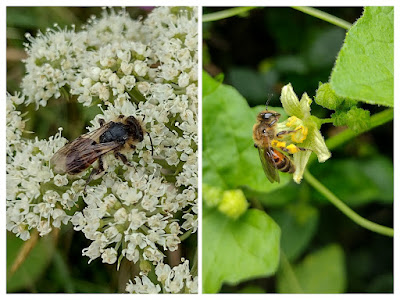 |
| Andrena rosae and Andrena florea |
 |
| Mines of Pseudodineura enslini on Trollius europaeus |
Diptera
The obvious highlight was adding Sylvicola fuscatus (Anisopodidae) new for the UK on an early spring visit to Ivinghoe with Matt Harrow. This is a species that has been recorded more widely on the continent recently so not too surprising an addition for the British list. Matt found another individual nearby later in the year so it is clearly established in the area. It will be interesting to see if it rapidly spreads across the south of England over the next couple of years. An article officially adding the species will be in the January 2022 edition of Dipterists Digest.
 |
| Sylvicola fuscatus |
Highlights of a trip to North Wales in May included the spider egg predator Trimerina madizans (Ephydridae) and the stripy Poecilolycia vittata (Lauxaniidae).
Still going through #Diptera from North Wales trip. Here is Poecilolycia vittata an uncommon and wonderfully stripy #Lauxaniidae swept from lowland heath on Ynys Môn pic.twitter.com/ElhlIkOfhw
— Sam Thomas (@sjthomasbotany) June 4, 2021
My first Scotland trip added a few nice species including the third UK record of Hydrophoria diabata (Anthomyiidae) from Glen Tilt, the northern snail-killing fly Ectinocera borealis (Sciomyzidae) from Ben Vrackie along with a suite of other upland species including Thricops hirtulus, T. nigritellus (Muscidae) and Platycheirus melanopsis (Syrphidae). Ben Lawers provided a range of infrequently recorded upland species including Heleomyza borealis (Heleomyzidae), Phaonia lugubris (Muscidae), Rhamphomyia morio (Empididae), Megaselia atrosericea (Phoridae) and Delia piliventris (Anthomyiidae). It was also nice to record the mines of Parallelomma paridis and P. vittatum (Scathophagidae) on Paris quadrifolia (Herb Paris) and Dactylorhiza (marsh orchid sp.) respectively.
#Heleomyzidae Heleomyza borealis, female, Ben Lawers, https://t.co/VBF2jXkwU9.21. A remarkably cold tolerant species that is widespread in the north of the UK. Length c. 6mm. #Diptera pic.twitter.com/39lVwRhcb6
— Sam Thomas (@sjthomasbotany) December 15, 2021
Another highlight was seeing the big furry asilid Laphria flava around Aviemore in June. I’ve always wanted to see this species which must be among the most impressive of british flies so it was nice to get good views including a pair mating on a massive fallen pine.
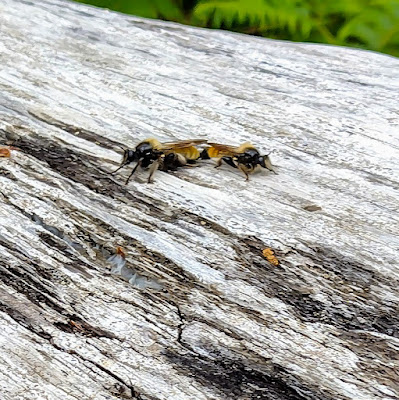 |
| Laphria flava |
Other nice species on my second Scotland trip included the rare Homalocephala biumbrata (Ulidiidae) associated with dead Aspen at Insh. At the same site I swept a single Pseudopomyza atrimana (Pseudopomyzidae) though I didn’t notice it in the field. P. atrimana is rarely recorded and the only member of the family in the UK so a nice species to find even if I was a bit squashed by the time I actually noticed it.
 |
| Homalocephala biumbrata |
Repeatedly sweeping wood ant nests finally paid off with a single individual of the myrmecophilous Phyllomyza formicae (Milichiidae). Sweeping around snow patches in the Cairngorms produced the alpine Muscidae species Spilogona alpica. While searching for Moneses uniflora at Glenmore I found a number of mines of Pegomya seitenstettensis (Anthomyiidae) on Oxalis acetosella (Wood Sorrel). I always check for this species when I see Oxalis acetosella but without any success which suggests it probably isn’t common, at least in the south.
Two #Muscidae from around snow-patches in the Cairngorms last week. The the uncommon S. alpica (top) and the widespread Spilogona solitariana (bottom) #Diptera pic.twitter.com/zyCgoeIYjO
— Sam Thomas (@sjthomasbotany) July 22, 2021
Much of my material from the summer still needs to be sorted so I’m sure I’ll find more nice species from Scotland and Wales over the next few months.
Butterflies
Having added a lot of new butterflies in 2021 I only saw three new species in 2022. A wonderful encounter with a Mountain Ringlet on the slopes above Lochan na Lairige near Ben Lawers on my birthday was a highlight. Additions this year were:
Pyrgus malvae Grizzled Skipper
Aricia artaxerxes Northern Brown Argus
Erebia epiphron Mountain Ringlet
Moths
I didn’t make it to 1000 moths in 2021 but added 33 new species taking me to 986.
I added a few new leafminers such as Enteucha acetosae, Ectoedemia erythrogenella, Phyllocnistis xenia, Stephensia brunnichella, Elachista poae and Elachista maculicerusella. Of these the mines of Britain's smallest moth Enteucha acetosae on coastal cliffs in Cornwall were a highlight.
Elachista poae and Elachista maculicerusella emerged today #moths https://t.co/enKFYj8MoQ pic.twitter.com/jzkheFsUKL
— Sam Thomas (@sjthomasbotany) April 10, 2021
 |
| Enteucha acetosae |
A trip to Holme Fen to target galls of Lampronia fuscatella on Betula was successful though my attempt to rear the adults and their species specific parasitic wasp was a failure.
 |
| Lampronia fuscatella gall on Betula |
I ran a trap in Abernethy Forest for a week in July which was probably too late for many of the local specialties but still added a few species including Parornix loganella, Coleophora tamesis, and Coleophora striatipennella. Elsewhere in Scotland I added Denisia similella, Rheumaptera hastata (Argent and Sable) and Macaria brunneata (Rannoch Looper). Finally seeing Argent and Sable was particularly pleasing as I undertook a number of unsuccessful surveys for the species in North Wales many years ago.
 |
| Macaria brunneata, Denisia similella and Rheumaptera hastata |
I managed to get the trap out for a few nights after moving to Hayling Island in September and was rewarded with a number of species that would until recently have been great rarities but are now frequent in the area. These were Blastobasis vittata, Cyclophora puppillaria (Blair's Mocha), Ochropleura leucogaster (Radford's Flame Shoulder), Trigonophora flammea (Flame Brocade) and Caradrina kadenii (Clancy's Rustic).
 |
| Trigonophora flammea, Caradrina kadenii, Ochropleura leucogaster and Cyclophora puppillaria |
Fish
I don’t normally record fish but the highlight of my one attempt at rock pooling was a Lepadogaster purpurea (Cornish Sucker) caught by Jacques at Kimmerange.
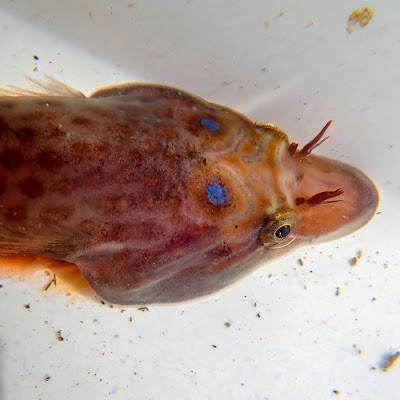 |
| Lepadogaster purpurea |
Birds
I didn’t hit my 300 life list target this year, starting on 278 and ending on 295. This included a quartet of Scottish species of which a chance encounter with a displaying male Capercaillie causing a traffic jam was a highlight. Three days of Scilly Pelagics were amazing with huge numbers of Manx Shearwater (Puffinus puffinus), good numbers of Sooty Shearwater (Ardenna grisea) and good views of an adult Sabine’s Gull (Xema sabini). The only new bird for me during the pelagics was Great Shearwater of which we had good views of multiple individuals. Finally making the trip to Bempton for the albatross was another highlight with great views of it wheeling around the cliffs. Again, I saw a few relatively common species that I hadn’t seen in the UK such as Temminck's Stint, Ferruginous Duck and Glaucous Gull. Other than that most species were the result of some of the most popular English 2021 twitches. New this year were:
Capercaillie Tetrao urogallus*
Ptarmigan Lagopus muta
Ferruginous Duck Aythya nyroca
White-tailed Plover Vanellus leucurus*
Pacific Golden Plover Pluvialis fulva*
Temminck's Stint Calidris temminckii*
Western Sandpiper Calidris mauri*
Glaucous Gull Larus hyperboreus
American Herring Gull Larus smithsonianus*
Black-browed Albatross Thalassarche melanophris*
Great Shearwater Ardenna gravis*
Golden Eagle Aquila chrysaetos
Crested Tit Lophophanes cristatus
River Warbler Locustella fluviatilis*
Northern Mockingbird Mimus polyglottos*
Bluethroat Luscinia svecica*
White-throated Sparrow Zonotrichia albicollis*
For the first time in many years I didn’t go abroad so the only additions to my Western Palearctic list were species seen in the UK and an armchair tick (the green bee-eater split Merops viridissimus and M. cyanophrys). Species that were WP additions as well as UK ticks are marked with an asterisk in the above list. This was a total addition of 13 species taking me to 380.
Mammals
I wasn’t expecting mammals to be the most exciting things I saw in 2021 as most years I see little more than a few foxes, grey squirrels, rabbits, rats, deer and a hare or two if I’m lucky. However this year was very different with three mammal highlights. The main one being the exceptional whale sightings on day three of my Scilly Pelagics. Birds were almost completely forgotten as we enjoyed the unexpected and amazing sight of Humpback and Fin Whales feeding around the boat. Both species put on an extraordinary show feeding on the surface for extended periods. In the end we saw at least two of each species as well as brief views of Minke Whale. Having never seen a whale before this experience was the my clear highlight of 2021 and is unlikely to be eclipsed anytime soon. Also on Scilly I I was pleased to find a Lesser White-Toothed Shrew under the first piece of wood I turned over on Porth Hellick Beach.
The cottage we stayed at in Abernethy Forest is well known for offering good views of pine marten and European badger (Meles meles) and it didn’t disappoint with both species coming to jam and peanut butter left out on the windowsills and patio.
Having had such an amazing year for mammals I then decided to devalue it all by adding human to my list.
Humpback Whale Megaptera novaeangliae
Fin Whale Balaenoptera physalus
Common Minke Whale Balaenoptera acutorostrata
Lesser White-Toothed Shrew Crocidura sauveolens
European Pine Marten Martes martes
Human Homo sapiens
Ended three days of @Scillypelagics with a bang today with amazing views of Humpback and Fin Whale as well as brief views of Minke. Good birding despite the easterly breeze included a few Great Shearwater, lots of Sooty, and an adult Sabines Gull. Back for Wilson's next year. pic.twitter.com/JphcsRiVYE
— Sam Thomas (@sjthomasbotany) August 29, 2021
Some pictures from the isles of Scilly @Scillypelagics of the humpback whale and the fin whale. Still blows my mind thinking about it. pic.twitter.com/zIIJe5GhMh
— Robert Gilbert (@ROBgilb) September 2, 2021
My shots of last Saturday's humpback with @Scillypelagics . In the second image you can see the baitfish pouring out of the side of it's mouth. It was truly awesome inspiring to see this enormous mammal at such close range and observe such active bubble net feeding. pic.twitter.com/uDNzZVhi2W
— Thomas Gibson (@GibsonTomgibo) September 4, 2021
Targets for 2022
I’ve set myself a more modest target for next year with an aim to reach 5800 by adding 559 species. I’ve left many of my unachieved targets unchanged including my ambition to record something from each of the PSL categories. Hopefully I’ll make more of an effort this year. Specific targets for next 2022 include my last two regular UK breeding birds: Lesser Spotted Woodpecker (Dendrocopos minor) and Stone Curlew (Burhinus oedicnemus). Having moved to Hayling Island I’m planning on spending more time exploring coastal habitats and visiting the New Forest. Also living on the south coast I’ll hopefully add a few more migrant moths. I haven’t finalised my UK trips yet but I’d like to finally do some Breckland botany, visit Teesdale, see my remaining missing species in the Bristol area, visit the Isle of Wight, and, possibly, the Channel Islands. Having missed out on Wilson’s Storm-Petrel (Oceanites oceanicus) gave me the perfect excuse to book another Scilly Pelagic for the coming August so hopefully this will be the year. Depending on travel conditions in January I’m hoping to spend two weeks in Guatemala which will be my first visit to the Americas. If all goes well I’ll start my Neotropical list with a bang with Horned Guan (Oreophasis derbianus) and many other new birds. I’m also hoping to make another visit to Israel in the spring and to make a first visit to Spain which should both add considerably to the WP list.
 |
| Summary of PSL for 2021 with targets for 2022 |



No comments:
Post a Comment